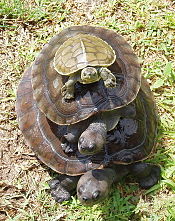| Malaysian giant turtle | |
|---|---|

| |
| Scientific classification | |
| Domain: | Eukaryota |
| Kingdom: | Animalia |
| Phylum: | Chordata |
| Class: | Reptilia |
| Order: | Testudines |
| Suborder: | Cryptodira |
| Superfamily: | Testudinoidea |
| Family: | Geoemydidae |
| Genus: | Orlitia Gray, 1873 |
| Species: | O. borneensis
|
| Binomial name | |
| Orlitia borneensis Gray, 1873
| |
| Synonyms[3] | |
| |
The Malaysian giant turtle or Bornean river turtle (Orlitia borneensis) is a species of turtle in the family Bataguridae. It is monotypic within the genus Orlitia.[3] It is found in Indonesia and Malaysia.[1]
This species is the largest freshwater turtle in Southeast Asia, reaching a maximum length of 80 cm (31 inches) and a maximum weight of up to 50 kg (110 pounds). It inhabits large lakes, swamps, and slow-flowing rivers. This mainly piscivorous (fish-eating) species has a dark brown or black carapace which is smooth and oval in shape and a pale yellowish-brown to off-white plastron. The head is powerful, with strong jaws and a slightly projecting snout, and the heads of adults are uniformly colored dark brown to black whereas juveniles are dark mottled with a pale line extending from the mouth to the back of the head.[4] It occasionally takes fallen fruit and may consume and other available vertebrate. This species is exported in huge amounts from Indonesia for its highly prized flesh and despite its rarity it is not protected in Malaysia.[5] Habitat destruction for palm oil plantations and poaching for the Chinese medicinal trade have also contributed to its Critically Endangered IUCN status.[4]
References
- ^ a b Horne, B.D.; Das, I.; Hamidy, A.; Kusrini, M.D.; Guntoro, J.; As-singkily, M. (2020). "Orlitia borneensis". IUCN Red List of Threatened Species. 2020: e.T15509A724972. doi:10.2305/IUCN.UK.2020-2.RLTS.T15509A724972.en. Retrieved 16 November 2021.
- ^ "Appendices | CITES". cites.org. Retrieved 2022-01-14.
- ^ a b Fritz Uwe; Peter Havaš (2007). "Checklist of Chelonians of the World". Vertebrate Zoology. 57 (2): 238. doi:10.3897/vz.57.e30895. ISSN 1864-5755. S2CID 87809001.
- ^ a b "Malaysian giant turtles". Bristol Zoo. Retrieved 2020-11-21.
- ^ "Wildlife of RER: Malaysian Giant Turtle". RESTORASI EKOSISTEM RIAU (RER) - Ecological Restoration | Protect and Restore Ecosystems. 2019-01-30. Retrieved 2020-11-21.


